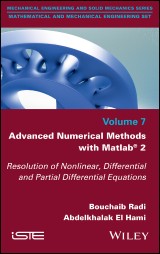Details
Advanced Numerical Methods with Matlab 2
Resolution of Nonlinear, Differential and Partial Differential Equations1. Aufl.
|
CHF 143.00 |
|
| Verlag: | Wiley |
| Format: | EPUB |
| Veröffentl.: | 24.05.2018 |
| ISBN/EAN: | 9781119527428 |
| Sprache: | englisch |
| Anzahl Seiten: | 224 |
DRM-geschütztes eBook, Sie benötigen z.B. Adobe Digital Editions und eine Adobe ID zum Lesen.
Beschreibungen
<p>The purpose of this book is to introduce and study numerical methods basic and advanced ones for scientific computing. This last refers to the implementation of appropriate approaches to the treatment of a scientific problem arising from physics (meteorology, pollution, etc.) or of engineering (mechanics of structures, mechanics of fluids, treatment signal, etc.). Each chapter of this book recalls the essence of the different methods resolution and presents several applications in the field of engineering as well as programs developed under Matlab software.</p>
<p>Preface ix</p> <p><b>Part 1. Solving Equations 1</b></p> <p><b>Chapter 1. Solving Nonlinear Equations 3</b></p> <p>1.1 Introduction 3</p> <p>1.2 Separating the roots 3</p> <p>1.3 Approximating a separated root 4</p> <p>1.3.1 Bisection method (or dichotomy method) 4</p> <p>1.3.2 Fixed-point method 6</p> <p>1.3.3 First convergence criterion 7</p> <p>1.3.4 Iterative stopping criteria.8</p> <p>1.3.5 Second convergence criterion (local criterion) 9</p> <p>1.3.6 Newton’s method (or the method of tangents) 10</p> <p>1.3.7 Secant method 12</p> <p>1.3.8 <i>Regula falsi method</i> (or false position method) 17</p> <p>1.4 Order of an iterative process.19</p> <p>1.5 Using Matlab 19</p> <p>1.5.1 Finding the roots of polynomials 19</p> <p>1.5.2 Bisection method 21</p> <p>1.5.3 Newton’s method 22</p> <p><b>Chapter 2. Numerically Solving Differential Equations 25</b></p> <p>2.1 Introduction 25</p> <p>2.2 Cauchy problem and discretization 27</p> <p>2.3 Euler’s method 30</p> <p>2.3.1 Interpretation 30</p> <p>2.3.2 Convergence 30</p> <p>2.4 One-step Runge–Kutta method 31</p> <p>2.4.1 Second-order Runge–Kutta method 32</p> <p>2.4.2 Fourth-order Runge–Kutta method 33</p> <p>2.5 Multi-step Adams methods 36</p> <p>2.5.1 Open Adams methods 36</p> <p>2.5.2 Closed Adams formulas 39</p> <p>2.6 Predictor–Corrector method.41</p> <p>2.7 Using <i>Matlab</i> 43</p> <p><b>Part 2. Solving PDEs 47</b></p> <p><b>Chapter 3. Finite Difference Methods 49</b></p> <p>3.1 Introduction 49</p> <p>3.2 Presentation of the finite difference method 51</p> <p>3.2.1 Convergence, consistency and stability 53</p> <p>3.2.2 Courant–Friedrichs–Lewy condition 56</p> <p>3.2.3 Von Neumann stability analysis 57</p> <p>3.3 Hyperbolic equations 58</p> <p>3.3.1 Key results 59</p> <p>3.3.2 Numerical schemes for solving the transport equation 63</p> <p>3.3.3 Wave equation 66</p> <p>3.3.4 Burgers equation 68</p> <p>3.4 Elliptic equations 72</p> <p>3.4.1 Poisson equation 72</p> <p>3.5 Parabolic equations 74</p> <p>3.5.1 Heat equation 74</p> <p>3.6 Using <i>Matlab</i> 76</p> <p><b>Chapter 4. Finite Element Method 83</b></p> <p>4.1 Introduction 83</p> <p>4.2 One-dimensional finite element methods 83</p> <p>4.3 Two-dimensional finite element methods 88</p> <p>4.4 General procedure of the method 93</p> <p>4.5 Finite element method for computing elastic structures 93</p> <p>4.5.1 Linear elasticity 93</p> <p>4.5.2 Variational formulation of the linear elasticity problem 97</p> <p>4.5.3 Planar linear elasticity problems 99</p> <p>4.5.4 Applying the finite element method to planar problems 101</p> <p>4.5.5 Axisymmetric problems.105</p> <p>4.5.6 Three-dimensional problems 107</p> <p>4.6 Using <i>Matlab</i> 107</p> <p>4.6.1 Solving Poisson’s equation 108</p> <p>4.6.2 Solving the heat equation.111</p> <p>4.6.3 Computing structures 112</p> <p><b>Chapter 5. Finite Volume Methods 117</b></p> <p>5.1 Introduction 117</p> <p>5.2 Finite volume method (FVM) 118</p> <p>5.2.1 Conservation properties of the method 118</p> <p>5.2.2 The stages of the method.119</p> <p>5.2.3 Convergence 120</p> <p>5.2.4 Consistency 120</p> <p>5.2.5 Stability 120</p> <p>5.3 Advection schemes 121</p> <p>5.3.1 Two-dimensional FVM. 126</p> <p>5.3.2 Convection-diffusion equation 129</p> <p>5.3.3 Central differencing scheme 131</p> <p>5.3.4 Upwind (decentered) scheme 133</p> <p>5.3.5 Hybrid scheme 136</p> <p>5.3.6 Power-law scheme 136</p> <p>5.3.7 QUICK scheme 137</p> <p>5.3.8 Higher-order schemes 139</p> <p>5.3.9 Unsteady one-dimensional convection-diffusion Equation 140</p> <p>5.3.10 Explicit scheme 142</p> <p>5.3.11 Crank–Nicolson scheme.142</p> <p>5.3.12 Implicit scheme 143</p> <p>5.4 Using <i>Matlab</i> 144</p> <p><b>Chapter 6. Meshless Methods. 147</b></p> <p>6.1 Introduction 147</p> <p>6.2 Limitations of the FEM and motivation of meshless methods 148</p> <p>6.3 Examples of meshless methods148</p> <p>6.3.1 Advantages of meshless methods 149</p> <p>6.3.2 Disadvantages of meshless methods150</p> <p>6.3.3 Comparison of the finite element method and meshless methods 151</p> <p>6.4 Basis of meshless methods 151</p> <p>6.4.1 Approximations 151</p> <p>6.4.2 Kernel (weight) functions.152</p> <p>6.4.3 Completeness 152</p> <p>6.4.4 Partition of unity 152</p> <p>6.5 Meshless method (EFG) 153</p> <p>6.5.1 Theory 153</p> <p>6.5.2 Moving Least-Squares Approximation 153</p> <p>6.6 Application of the meshless method to elasticity 163</p> <p>6.6.1 Formulation of static linear elasticity 163</p> <p>6.6.2 Imposing essential boundary conditions 165</p> <p>6.7 Numerical examples 170</p> <p>6.7.1 Fixed-free beam 170</p> <p>6.7.2 Compressed block 171</p> <p>6.8 Using <i>Matlab</i> 173</p> <p><b>Part 3. Appendices 179</b></p> <p>Appendix 1181</p> <p>Appendix 2189</p> <p>Bibliography 195</p> <p>Index 199</p>
<strong>Abdelkhalak El Hami</strong> is Professeur des Universités at the Institut National des Sciences Appliquées (INSA-Rouen) in France and is in charge of the Normandy Conservatoire National des Arts et Metiers (CNAM) Chair of Mechanics, as well as several European pedagogical projects. He is an expert in fluid-structure interaction studies and reliability. <p><strong>Bouchaib Radi</strong> is Professor of Higher Education in the Faculty of Science and Technology of Settat Hassan First University in Morocco. His work specializes in material forming processes, optimization and reliability.


















